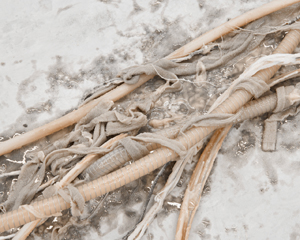11.27.23 — Depression and Disgust
Well, okay, one more review that somehow slipped through the cracks this fall. Mire Lee does everything she can to turn you away. Elevator doors at the New Museum opened not long ago onto barely enough room to exit and the face of a seemingly unfinished wall.
On my first attempt to get past, a curatorial assistant turned me away. She said that the installation was not quite ready, and it does depend on a messy assemblage of motors and materials to set it in motion. Still, could it have fooled even her? Lee has many more deceptions in store, and she is out quite literally to take you in, with Black Sun through September 27. 
Just for starters, what looked like bare Sheetrock and metal studs is anything but. It is complete enough, thank you, and of materials better suited to retain raw feelings, moisture, and the smell. What promised a partition, waiting to display and beyond it to disclose her art, is just one wall of a tarnished shelter filling much of the museum’s top floor. It has ample room for museum visitors, but it is stifling enough all the same. The skylit floor that so opened up last year for Kapwani Kiwanga has become confining, doubling the museum walls and then some. Just entering, through two sets of vertical plastic blinds, should let you know.
Once inside, you may have an overpowering urge to leave. Two pits in the floor hold the very blood and guts of art. One sculpture, like her Endless House at the Venice Biennale, looks like oversized intestines starved for a meal. It really might take you in. The other could be a whole body, threateningly large, but flayed and left to die. I thought that I could make out a penis, but after that you are on your own.
Each sculpture is also part of or subject to a machine. It drips its thick white goo into the pits, where small rods at the edges churn the mixture as best they can. It leaves its dark stains on the slick walls and its odor of gelatin, silicone, plaster, and oil in the air. It may have you in need of fresh air not because it is all that intense, but because it is gross. Then again, you may hesitate to leave, despite yourself. This is after all material for thought and for art.
Like Sue de Beer before her, the Korean artist takes her title from a book by Julia Kristeva that gives voice to depression, the French writer’s included. As a theorist with roots in psychoanalysis, she has much in common with Jacques Lacan, but with less post-structuralist jargon and a greater openness to art. Art, she writes, can “bypass complacency,” and beauty can be sad, because it “is inseparable from the ephemeral and hence from mourning.” (Think of the ephemeral in, say, the constant motion of a machine.) It returns her to the tradition of Sigmund Freud—for whom depression was “melancholia,” the body was inescapable, and disgust was a way of distancing oneself from desires and fears. Kristeva gives her longest chapter to the stark nudity of Hans Holbein and his Dead Christ in the Tomb.
Minimalism this is not, but it does have Post-Minimalism’s bodily presence and fears, from Eva Hesse to the present. Is this pretentious as well as disgusting? Maybe so, but the machine and the body take many forms. Off to the side, a video has abstract shapes, artificial materials, or bodily forms in motion, and I hesitate to say which. (I thought first of walruses.) But then I was inside, where the remaining were at least in part my own.
Lee’s environment is hardly paradise, but then what is? A seventy-foot mural in the lobby gallery shows Eden itself as an unruly place—enough to accommodate Lilith, Adam’s first wife in myth. A “she-demon” who raised his children while refusing to grant him supremacy, she has no place in the Bible, but she does turn up in The Original Riot, by Wynnie Mynerva. Born on the outskirts of Lima, in Peru, Mynerva relishes a spoiled paradise, with lush brushwork to match. Not that one can make out a story or, for that matter, count the characters. But, hey, it’s a jungle out there.
Read more, now in a feature-length article on this site.